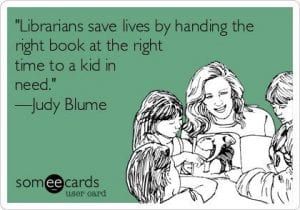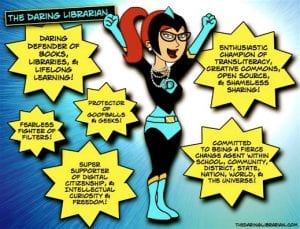My path to the role of teacher librarian is but a fortuitous accident. A recent graduate, blissfully unaware of the actual requirements, I blithely applied for the role citing my repertoire of favourite novels, familiarity with Dewey and my flexible nature in the requested selection criteria. In hindsight, I flinch at my old self, but obviously the principal saw something within me that I had not envisaged. Fast forward six months, and I have gained valuable insight into the role of a teacher librarian; progressed to full registration and now am a permanent member of staff as a teacher librarian.

Figure 1 – Trombetta (2017)
The role of a teacher librarian has changed dramatically from memories of high school, which had T/L as the “the literature expert at the school” (Braxton 2008). These bastions of knowledge, could with great skill, able to place the right books into correct hands using age, developmental ability, curriculum and abilities as criteria. But these days, the teacher librarian themselves have grown into a powerful resource due to the dynamic way information is now sourced.
The advent of the portable devices and the ubiquitous use of the internet has permanently changed how we learn. Instead of numerous shelves holding reference books, journals and encyclopaedias, most school libraries are equipped with databases, online newspapers and encyclopaedias with a significantly smaller physical collection. But with such transition comes with a transformation in practice and this has been described by ALIA (2004) – Teacher Librarian in their standards.
The first role of a TL is a curriculum leader. Whilst wearing this hat, T/Ls work with heads of departments and the executive to ensure that information literacy skills are embedded across the curriculum and school. They work with classroom teachers to “plan, teach and evaluate…to ensure the effective integration of information resources and technologies into student learning” ASLA & ALIA (2014). This role extends to ensuring access for students with diverse learning needs, cultural backgrounds and for students where social justice may lead to inequity. (Braxton 2008)
An information specialist is another aspect of the role. Being able to obtain, interpret, provide access and assist students as well as staff in utilising the information management system available. ASLA & ALIA (2014) clearly state the importance of providing “specialist assistance to students using technology and information resources in and beyond the school and for independent research”. This is further substantiated by the General Capabilities curriculum which promotes the need of students to become independent learners with a life long learning capacity (ACARA 2014).
Figure 2 – Trombetta (2017)
The last countenance that ASLA & ALIA (2014) deems to be part of a TL role is as an information services manager. It seems redundant to point out that teacher librarians are also responsible for maintaining the resource collection whether it be physical or electronic. A TL must also be able to select resources that fulfil the needs of the curriculum as well as meet the needs of the students within the policies, budget and moral frameworks of the school.
So basically, a T/L is a multifaceted superhero fighting a battle against illiteracy and promoting critical thinking… without wings.

Figure 3 – Superhero Teacher Librarian (Jones, G., 2011)
ACARA (2014) General Capabilities Curriculum Overview. https://australiancurriculum.edu.au/f-10-curriculum/general-capabilities/ accessed 6/3/19
ALIA (2004) ALIA/ASLA standards of professional excellence for teacher librarians. https://www.alia.org.au/about-alia/policies-standards-and-guidelines/standards-professional-excellence-teacher-librarians accessed 6/3/19
ASLA & ALIA (2014) Learning for the future: developing information services in schools, 2nd Ed. Cited in https://asla.org.au/what-is-a-teacher-librarian (accessed 6/3/19)
Braxton B., (2008) Teacher Librarian as literacy leader. Teacher Librarian 35 (3)
Costello, C., (2016) The role of TLs. https://www.virtuallibrary.info/tl-musings/the-role-of-tls accessed 6/3/19
Jones, G., (2011) Daring librarian. http://daringlibrarian.com/portfolio/public_html/About_Me.html accessed 6/3/19
Trombetta, S., (2017) 17 quotes that prove librarians are the best. Bookbub. https://www.bookbub.com/blog/2017/01/19/quotes-about-how-much-we-love-librarians accessed 6/3/19


